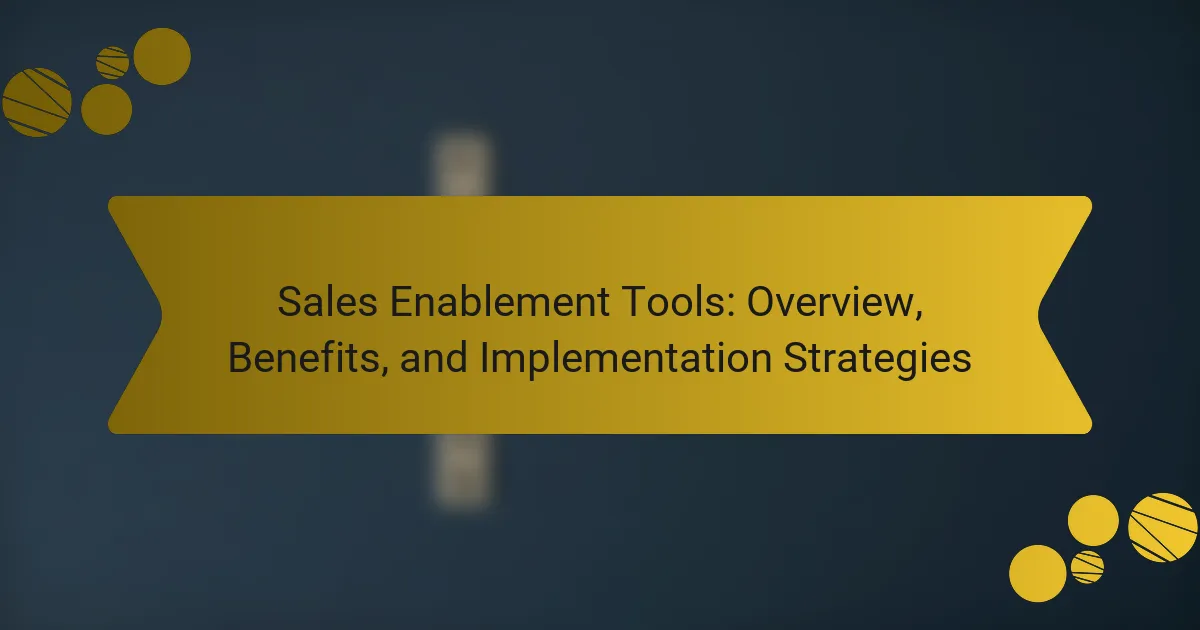Sales enablement tools are software solutions that enhance the efficiency and effectiveness of sales teams by providing essential resources such as training materials, content management, and analytics. These tools facilitate improved communication between sales and marketing departments, track customer interactions, and monitor sales performance. Research indicates that organizations utilizing sales enablement tools experience significant increases in sales productivity and win rates. Effective implementation strategies include aligning tools with sales processes, providing user training, integrating with existing systems, and setting measurable goals to ensure ongoing effectiveness. Overall, sales enablement tools play a crucial role in driving revenue growth and enhancing customer relationships.

What are Sales Enablement Tools?
Sales enablement tools are software solutions designed to enhance the efficiency and effectiveness of sales teams. They provide resources such as training materials, content management, and analytics to support sales processes. These tools aim to streamline communication between sales and marketing departments. They also help in tracking customer interactions and sales performance. According to a study by CSO Insights, companies using sales enablement tools see a 15% increase in sales productivity. This demonstrates their impact on improving sales outcomes.
How do Sales Enablement Tools function in a business environment?
Sales enablement tools function by providing resources that enhance the sales process. These tools streamline communication between sales teams and marketing. They offer access to training materials, product information, and customer insights. This ensures sales representatives are well-informed and prepared. Sales enablement tools also facilitate tracking of sales performance metrics. They enable management to analyze data for continuous improvement. By integrating CRM systems, these tools enhance customer relationship management. Overall, they increase efficiency and effectiveness in sales activities.
What key features are typically included in Sales Enablement Tools?
Sales enablement tools typically include features such as content management, training resources, and analytics. Content management allows sales teams to access up-to-date materials easily. Training resources provide onboarding and ongoing education for sales personnel. Analytics features track engagement and performance metrics. Collaboration tools facilitate communication among team members. Integration capabilities connect with CRM systems for streamlined workflows. Customization options allow businesses to tailor tools to their specific needs. These features collectively enhance sales effectiveness and improve overall performance.
How do these features enhance sales processes?
Sales enablement tools enhance sales processes by streamlining communication and improving access to resources. These tools provide sales teams with centralized information, enabling them to respond to customer inquiries quickly. They also offer analytics that help identify successful strategies and areas for improvement. By automating repetitive tasks, sales enablement tools allow representatives to focus on building relationships with prospects. Furthermore, training features help onboard new team members efficiently, increasing overall productivity. Studies show that organizations using sales enablement tools see a 20% increase in sales productivity. This proves the effectiveness of these features in enhancing sales processes.
Why are Sales Enablement Tools essential for modern sales teams?
Sales enablement tools are essential for modern sales teams because they streamline processes and enhance productivity. These tools provide access to resources, training, and analytics that improve sales performance. According to a study by CSO Insights, organizations with effective sales enablement strategies achieve 15% higher win rates. Additionally, sales enablement tools facilitate better communication and collaboration among team members. They also help in personalizing customer interactions, leading to increased engagement and satisfaction. As a result, sales teams can respond more effectively to market changes and customer needs.
What challenges do Sales Enablement Tools address for sales professionals?
Sales Enablement Tools address several challenges for sales professionals. They streamline access to essential resources and information. This reduces time spent searching for materials. Sales Enablement Tools also enhance communication between teams. Improved collaboration leads to better alignment on goals and strategies. Additionally, these tools provide training and onboarding support. This helps new sales professionals become productive faster. They also offer analytics to track performance and identify areas for improvement. This data-driven approach enables continuous optimization of sales strategies. Overall, Sales Enablement Tools significantly improve efficiency and effectiveness in sales processes.
How do Sales Enablement Tools improve collaboration within teams?
Sales enablement tools improve collaboration within teams by providing centralized access to resources and information. These tools facilitate communication among team members through shared platforms. They enable real-time updates and feedback, which enhances responsiveness. Sales enablement tools also streamline training and onboarding processes, ensuring everyone is aligned. According to a study by HubSpot, teams using sales enablement tools report a 20% increase in collaboration. This increase is attributed to better resource sharing and improved workflow management. Overall, these tools foster a more cohesive team environment.

What are the benefits of using Sales Enablement Tools?
Sales enablement tools enhance sales team performance and efficiency. They provide access to relevant content and resources, streamlining the sales process. These tools improve communication between sales and marketing teams. They also enable better tracking of customer interactions and sales activities. Research indicates that organizations using sales enablement tools experience a 15% increase in sales productivity. Additionally, they can lead to a 20% increase in win rates. By offering training and onboarding resources, these tools shorten the ramp-up time for new sales representatives. Overall, sales enablement tools drive revenue growth and improve customer relationships.
How do Sales Enablement Tools increase sales productivity?
Sales enablement tools increase sales productivity by providing resources and insights that streamline the sales process. These tools offer access to training materials, product information, and customer data. Sales teams can quickly find relevant content to engage prospects effectively. They also enable better collaboration among team members. Enhanced communication leads to faster decision-making and improved sales strategies. According to a study by the Sales Management Association, organizations that utilize sales enablement tools see a 15% increase in sales productivity. This boost is attributed to more efficient workflows and reduced time spent on administrative tasks.
What metrics can be used to measure productivity improvements?
Key metrics to measure productivity improvements include output per hour, employee engagement scores, and sales conversion rates. Output per hour quantifies the amount of work completed in a specified timeframe. Employee engagement scores reflect team morale and motivation, which directly influence productivity. Sales conversion rates indicate the effectiveness of sales efforts in turning leads into customers. Tracking these metrics provides a clear picture of productivity enhancements over time. For instance, a study by McKinsey & Company found that productivity can increase by 20-25% in organizations that effectively measure and analyze these metrics.
How do Sales Enablement Tools streamline training and onboarding?
Sales enablement tools streamline training and onboarding by providing centralized resources and structured learning paths. These tools offer interactive content, such as videos and quizzes, to engage new hires effectively. They enable real-time access to training materials, allowing employees to learn at their own pace. Additionally, analytics features track progress and identify knowledge gaps. This data-driven approach ensures tailored training experiences. According to a study by CSO Insights, companies using sales enablement tools see a 15% increase in onboarding efficiency. Thus, these tools enhance the training process, making it more efficient and effective.
What impact do Sales Enablement Tools have on customer engagement?
Sales enablement tools significantly enhance customer engagement. These tools provide sales teams with resources that facilitate effective communication with customers. They streamline information sharing, allowing for timely and relevant interactions. According to a study by HubSpot, organizations using sales enablement tools experience a 14% increase in sales productivity. This productivity boost leads to more meaningful customer interactions and higher satisfaction rates. Furthermore, sales enablement tools help personalize customer experiences, which fosters loyalty and trust. Research from CSO Insights indicates that companies with a formal sales enablement strategy see a 20% improvement in win rates. Thus, sales enablement tools play a crucial role in driving customer engagement through improved communication, productivity, and personalization.
How do these tools help in personalizing customer interactions?
Sales enablement tools help in personalizing customer interactions by providing data-driven insights. These tools collect and analyze customer data, including preferences and behaviors. They enable sales teams to tailor their messaging and offers to individual customers. Personalized communication increases engagement and satisfaction. Additionally, these tools facilitate tracking customer interactions over time. This tracking allows for adjustments based on previous responses. Studies show that personalized interactions can lead to higher conversion rates. For instance, a report from McKinsey indicates that personalization can increase sales by 10% to 30%.
What role do Sales Enablement Tools play in understanding customer needs?
Sales Enablement Tools enhance the understanding of customer needs by providing data-driven insights. These tools aggregate customer interactions and feedback, enabling sales teams to analyze preferences and pain points. For example, platforms like CRM systems track customer behavior and engagement patterns. This data helps in tailoring sales strategies to meet specific customer requirements. Additionally, Sales Enablement Tools offer training resources that equip sales representatives with knowledge about customer personas. This knowledge fosters more meaningful conversations with clients. Research shows that companies using these tools see a 20% increase in sales effectiveness. Thus, Sales Enablement Tools play a critical role in aligning sales efforts with customer expectations.

What are effective implementation strategies for Sales Enablement Tools?
Effective implementation strategies for Sales Enablement Tools include aligning tools with sales processes. This ensures that the tools support the workflows of sales teams. Training is essential for users to understand features and benefits. Regular feedback from users helps refine tool usage and identify gaps. Integration with existing systems enhances data flow and usability. Setting measurable goals tracks the effectiveness of the tools. Continuous evaluation and adjustment of strategies ensure ongoing relevance. Research shows that organizations with aligned tools see a 20% increase in sales productivity.
How should a business assess its needs before implementing Sales Enablement Tools?
A business should assess its needs by identifying specific sales challenges and goals. This involves analyzing current sales processes and performance metrics. Understanding the gaps in knowledge or resources is essential. Engaging with sales teams for feedback can provide valuable insights. Evaluating the technology currently in use helps identify integration needs. Reviewing customer interactions can highlight areas for improvement. Conducting a competitive analysis may reveal industry standards and expectations. Documenting these findings creates a clear roadmap for selecting appropriate Sales Enablement Tools.
What factors should be considered during the evaluation process?
Key factors to consider during the evaluation process of sales enablement tools include alignment with business goals, user experience, and integration capabilities. Evaluating alignment ensures the tool meets specific sales objectives. User experience affects adoption rates and overall effectiveness. Integration capabilities are crucial for seamless operation with existing systems. Additionally, cost versus value is important for budget considerations. Scalability should be assessed to accommodate future growth. Support and training resources influence user proficiency. Finally, data security measures are essential to protect sensitive information.
How can businesses align their sales goals with the features of the tools?
Businesses can align their sales goals with the features of sales enablement tools by ensuring that tool functionalities directly support specific sales objectives. First, they should identify key sales goals, such as increasing lead conversion rates or shortening sales cycles. Next, businesses must evaluate the features of the tools available, including analytics, content management, and customer relationship management capabilities.
For instance, if a goal is to improve lead conversion, tools with robust analytics can help track customer engagement and refine strategies. Additionally, training sales teams on how to leverage these features effectively is essential. This ensures that the tools are utilized to their fullest potential, directly contributing to achieving sales targets.
Research indicates that companies using sales enablement tools report a 15% increase in sales productivity (Forrester Research). This statistic reinforces the importance of aligning tool features with sales objectives for optimal performance.
What steps are involved in successfully implementing Sales Enablement Tools?
Identify business goals and objectives. This step aligns sales enablement tools with company strategy. Conduct a needs assessment to understand the specific requirements of the sales team. This ensures the selected tools address actual challenges. Research and select appropriate sales enablement tools based on the assessment. Evaluate features, integrations, and user-friendliness during this process. Develop a clear implementation plan with timelines and responsibilities. This plan guides the deployment of tools effectively. Train the sales team on how to use the tools efficiently. Comprehensive training enhances user adoption and maximizes tool benefits. Monitor and evaluate the effectiveness of the tools post-implementation. Regular assessment helps identify areas for improvement and optimization. Adjust strategies based on feedback and performance metrics. This ensures the tools continue to meet evolving sales needs.
How can organizations ensure user adoption of these tools?
Organizations can ensure user adoption of sales enablement tools by providing comprehensive training and support. Training equips users with the necessary skills to utilize the tools effectively. Ongoing support helps address any challenges users face during implementation. Additionally, organizations should involve users in the selection process to increase buy-in. Research shows that user involvement leads to higher adoption rates. Clear communication about the benefits of the tools also fosters acceptance. According to a study by McKinsey, organizations that communicate effectively see a 70% increase in user engagement. Lastly, organizations should monitor usage and gather feedback to make continuous improvements.
What training resources are available for maximizing tool effectiveness?
Training resources for maximizing tool effectiveness include online courses, webinars, and user manuals. Online courses offer structured learning on specific tools. Webinars provide real-time insights and best practices from experts. User manuals serve as detailed guides for tool functionalities. Additionally, vendor support and community forums facilitate peer learning and troubleshooting. Research indicates that organizations using comprehensive training see a 20% increase in tool adoption rates. These resources collectively enhance user proficiency and overall tool effectiveness.
What best practices should be followed when using Sales Enablement Tools?
Utilizing Sales Enablement Tools effectively requires adherence to several best practices. First, ensure alignment between marketing and sales teams. This fosters a unified approach to messaging and content. Second, regularly update training materials and resources. Keeping content current enhances sales representatives’ knowledge and confidence. Third, leverage analytics to track tool usage and performance. Data-driven insights allow for continuous improvement of strategies. Fourth, provide ongoing support and training for users. This ensures that teams can maximize the tools’ potential. Lastly, encourage feedback from users. This input is vital for refining processes and tools. Implementing these practices can significantly enhance the effectiveness of Sales Enablement Tools.
How can teams regularly evaluate the effectiveness of their Sales Enablement Tools?
Teams can regularly evaluate the effectiveness of their Sales Enablement Tools through systematic metrics and feedback loops. They should track usage statistics to determine how often tools are accessed and utilized by sales teams. Additionally, measuring the impact on sales performance is crucial. This can include analyzing conversion rates and sales cycle length before and after tool implementation. Gathering qualitative feedback from users can provide insights into usability and satisfaction. Regular training and assessments can also help identify areas for improvement. Benchmarking against industry standards can offer a comparative perspective on tool effectiveness. Conducting quarterly reviews can ensure continuous alignment with sales goals and objectives.
What common pitfalls should be avoided during implementation and use?
Common pitfalls to avoid during implementation and use of sales enablement tools include lack of clear objectives. Without defined goals, teams may struggle to align their efforts. Another pitfall is insufficient training for users. Sales teams need comprehensive training to utilize tools effectively. Additionally, neglecting to integrate tools with existing systems can lead to inefficiencies. Tools should complement current workflows for maximum productivity. Failing to gather user feedback is also detrimental. Regular input from users helps refine tool usage and improves outcomes. Lastly, overlooking data analysis can hinder progress. Monitoring key performance indicators is essential for evaluating success and making necessary adjustments.
Sales enablement tools are software solutions designed to enhance the efficiency and effectiveness of sales teams by providing resources such as training materials, content management, and analytics. This article explores the key features and benefits of sales enablement tools, including their role in improving collaboration, increasing sales productivity, and personalizing customer interactions. It also outlines effective implementation strategies, factors to consider during evaluation, and best practices for maximizing tool effectiveness. Additionally, the article addresses common challenges faced by sales professionals and how these tools can help overcome them, ultimately driving revenue growth and improving customer relationships.
